The Apple Lisa Office System package designs recreated
March 26, 2020
In 1980, Apple Computer asked a group of guys fresh from Stanford’s product design program to take a $400 device and make it mass-producible, reliable and cheap.
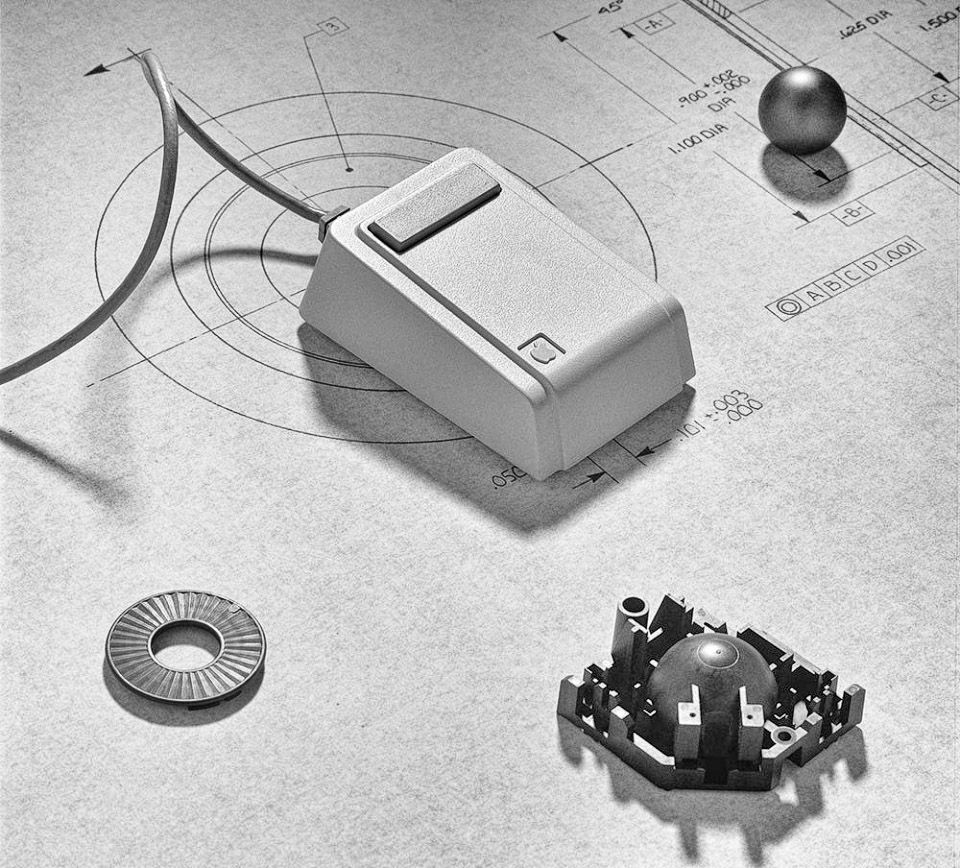 Jobs wanted Hovey-Kelley to take a piece of technology developed by some of Silicon Valley’s greatest minds, dramatically improve its reliability and cut its price by more than 90 percent. They did. The mouse’s evolution “from the laboratory to the living room,” as one of its designers puts it, is not well known—even some Apple fanatics aren’t familiar with it—but it reveals something of the personalities of its designers, the Stanford program that trained them and even the history of Silicon Valley.
Jobs wanted Hovey-Kelley to take a piece of technology developed by some of Silicon Valley’s greatest minds, dramatically improve its reliability and cut its price by more than 90 percent. They did. The mouse’s evolution “from the laboratory to the living room,” as one of its designers puts it, is not well known—even some Apple fanatics aren’t familiar with it—but it reveals something of the personalities of its designers, the Stanford program that trained them and even the history of Silicon Valley.
Hovey-Kelley Design, had been working on projects for Apple Computer for a couple of years but wanted to develop entire products, not just casings and keyboards. Hovey had come to pitch Apple co-founder Steven Jobs some ideas. But before he could get started, the legendary high-tech pioneer interrupted him. “Stop, Dean,” Hovey recalls Jobs saying. “What you guys need to do, what we need to do together, is build a mouse.”
Hovey was dumbfounded. A what?
Their work transformed personal computing with the launch of the Apple Lisa, which turned out to be a commercial failure for Apple, the largest since the Apple III disaster of 1980. The intended business computing customers balked at Lisa’s high price and largely opted to run less expensive IBM PCs, which were already beginning to dominate business desktop computing. The largest Lisa customer was NASA, which used LisaProject for project management and which was faced with significant problems when the Lisa was discontinued.
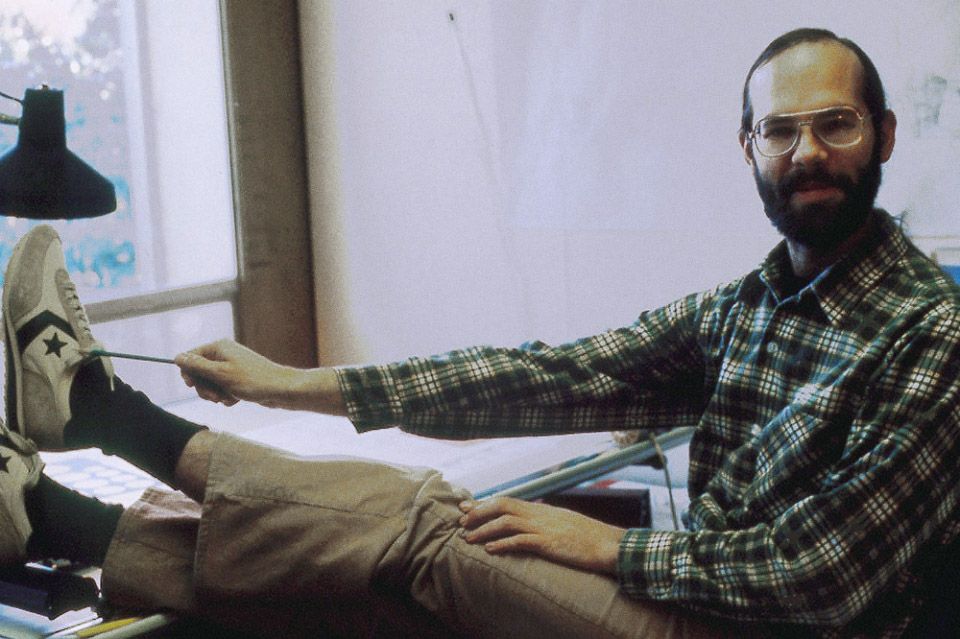 Fail? Hardly. The Apple mouse transformed personal computing. Although the expensive Lisa flopped, the Macintosh, released in 1984, made the graphical user interface the industry standard. Microsoft responded with Windows, and its own mouse—also engineered by Lisa Mouse Designer, Jim Yurchenco.”
Fail? Hardly. The Apple mouse transformed personal computing. Although the expensive Lisa flopped, the Macintosh, released in 1984, made the graphical user interface the industry standard. Microsoft responded with Windows, and its own mouse—also engineered by Lisa Mouse Designer, Jim Yurchenco.”
 The designers at Hovey-Kelley gather at a company retreat in Lake Tahoe around 1980. From left, in back, Jim Yurchenco, Jim Sachs, Douglas Dayton, Claire Hahn, and David Kelley. Meg Dayton and Liz and Dean Hovey sit on the log.
The designers at Hovey-Kelley gather at a company retreat in Lake Tahoe around 1980. From left, in back, Jim Yurchenco, Jim Sachs, Douglas Dayton, Claire Hahn, and David Kelley. Meg Dayton and Liz and Dean Hovey sit on the log.
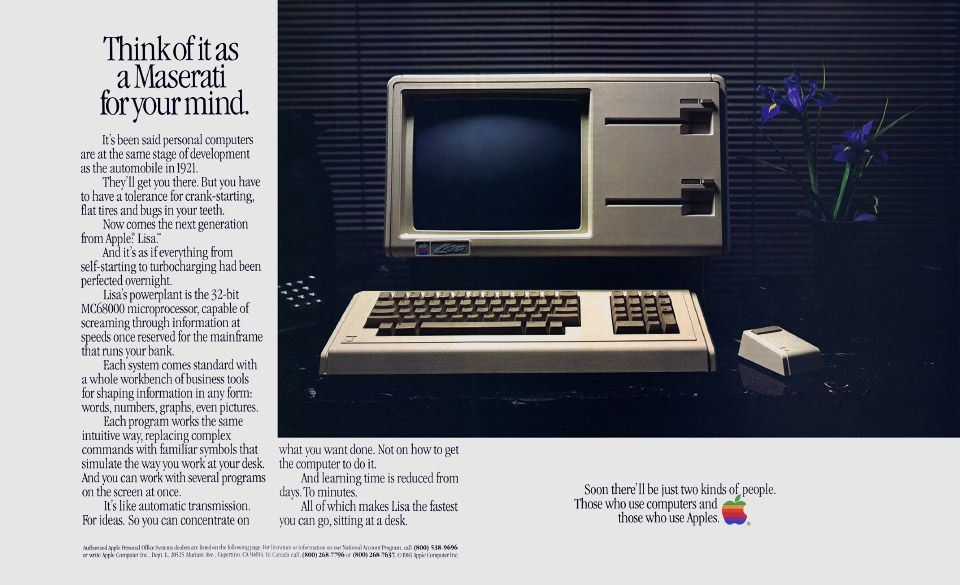 Tagline: “Soon there’ll be just two kinds of people. Those who use computers and those who use Apples.” Macintosh was later considered the computer “For the rest of us”. And while Jobs spoke about the computer as “the bicycle for the mind.”, the ad agency that put this ad together felt that a Maserati was that much more distinct.
Tagline: “Soon there’ll be just two kinds of people. Those who use computers and those who use Apples.” Macintosh was later considered the computer “For the rest of us”. And while Jobs spoke about the computer as “the bicycle for the mind.”, the ad agency that put this ad together felt that a Maserati was that much more distinct.

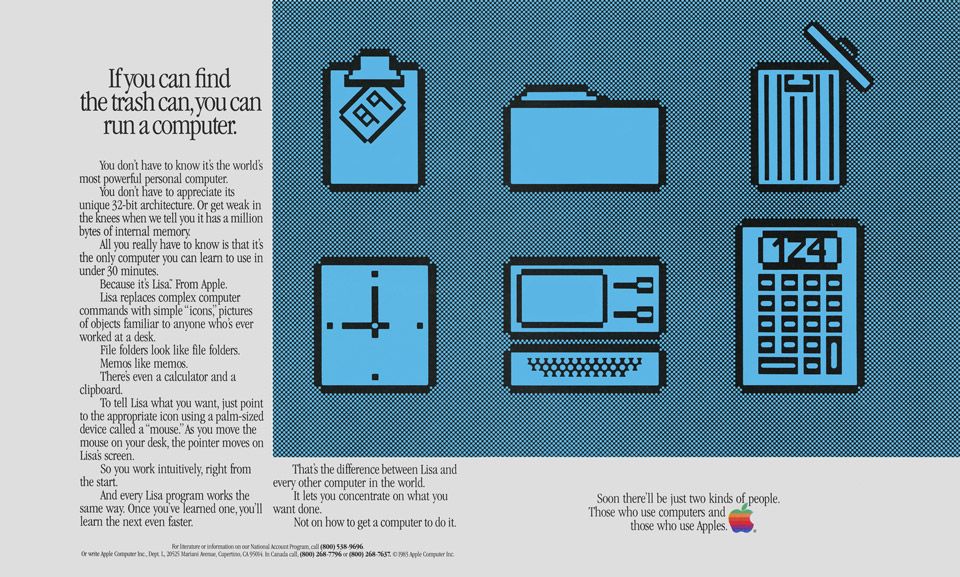
“So advanced, you already know how to use it.”
“If you can find the trash can, you can run a computer.”
Conceptually, the Lisa resembles the Xerox Star in the sense that it was envisioned as an office computing system; consequently, Lisa has two main user modes: the Lisa Office System and the Workshop. The Lisa Office System is the GUI environment for end users. The Workshop is a program development environment, and is almost entirely text-based, though it uses a GUI text editor. The Lisa Office System was eventually renamed “7/7”, in reference to the seven supplied application programs: LisaWrite, LisaCalc, LisaDraw, LisaGraph, LisaProject, LisaList, and LisaTerminal.
Download the Lisa marketing PDFs
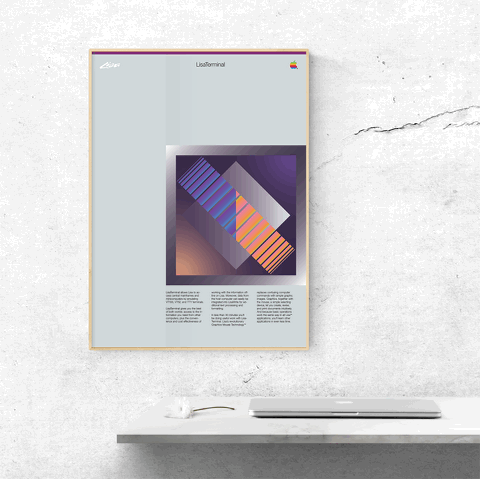
NOTE: The linked Dropbox previews lack fidelity. For proper rendition open directly in Adobe Acrobat Reader DC, Apple Preview or equivalent. It appears Dropbox engages some image proxy technology to display PDFs in the browser, resulting in significant image degradation.
Artwork output summary
- Color Space: CMYK
- Format: PDF, compatible with Acrobat 6 (PDF 1.5)
- Dimensions: W 101.02cm x H 142.87cm including 0.3cm bleed
- Preserved Adobe Illustrator editing capabilities
- Compressed Text and Line Art
- All Printer Marks, Trim Marks, Registration Marks, Color Bars, Page Information, Roman Printer Mark Type, Trim Mark Weight 0.25pt, offset 0.212cm, Document Bleed set to 0.3cm
- No Color Conversion, no color profile included
Save PDF summary
Adobe PDF Preset: Custom
Compatibility: Acrobat 6 (PDF 1.5)
Standard: None
Description
- [Based on ‘Illustrator Default’] These are the default settings when saving an Illustrator file as an Adobe PDF document. Use these settings when you plan on editing the file again in Illustrator, or when you need to place it in a layout application such as InDesign, or when the final use of the file is unknown.
General
- Preserve Illustrator Editing Capabilities: On
- Embed Page Thumbnails: On
- View PDF File after Saving: On
- Optimize for Fast Web View: Off
- Create Acrobat Layers from Top-Level Layers: On
Compression
- Color Bitmap Images:
- No Sampling Change
- Compression: ZIP
- No Sampling Change
- Grayscale Bitmap Images:
- No Sampling Change
- Compression: ZIP
- No Sampling Change
- Monochrome Bitmap Images:
- No Sampling Change
- Compression: ZIP
- No Sampling Change
- Compress Text and Line Art: On
- Color Bitmap Images:
Marks and Bleeds
- Trim Marks: On
- Registration Marks: On
- Color Bars: On
- Page Information: On
- Printer Mark Type: Roman
- Trim Mark Weight: 0.25 pt
- Offset from Artboard: 0.212 cm
- Use Document Bleed: On
- Trim Marks: On
Output
- Color:
- Color Conversion: No Conversion
- Profile Inclusion Policy: Don’t Include Profiles
- Color Conversion: No Conversion
- Color:
Advanced
- Subset embedded fonts below: 100 %
- Subset embedded fonts below: 100 %
Security
- Document Open Password: Off
- Permissions Password: Off
- Encryption Level: High (128-bit RC4) - Acrobat 5 and later
- Document Open Password: Off
This post and the accompanying PDFs are published under the GNU General Public License